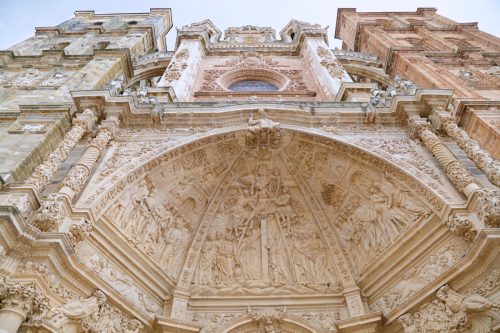Valentine’s Day History: From How It Started to Now

What began as an ancient Roman festival has through time become the romantic holiday we know today. Below, we’ll introduce you to every twist and turn that helped pave Valentine’s Day history. We’ll trace its early pagan roots, the impact of Christian traditions on the day, and its modern commercialization to explain into how February 14 became synonymous with love and romance across the globe. Read on to learn more.
RELATED: 53 Heartwarming Facts That Will Instantly Make You Smile.
Valentine’s Day Origins: From Pagan Rituals to Christian Feast
Long before Valentine’s Day became a symbol of romantic love, there was the Roman festival of Lupercalia. This pagan celebration, observed from February 13 to 15, involved the sacrifice of a goat and a dog, followed by a ritual in which young men, clad in the sacrificed animals’ hides, struck young women in a bid to ensure their fertility.
Why animal hides, you may ask? Well, the idea was to honor the founders of Rome, Romulus and Remus, who were raised by a she-wolf, or lupa. Though a strange courtship ritual by modern standards, it was believed that the women touched by these hides would become fertile and bear healthy children. While rituals like this one may seem strange to us today, they were an important part of the ancient Roman culture and beliefs, especially during the third century.
As time went on, however, the Catholic Church became steadfast in its mission to replace pagan practices with Christian ones. Eventually, Pope Gelasius I supplanted Lupercalia’s wild festivities with a more somber feast day in honor of the Christian martyr Saint Valentine, the Patron Saint of Love.
The Making of a Martyr: Saint Valentine’s Tale

The identity of St. Valentine remains somewhat murky, given the existence of several Christian martyrs bearing the same name. One of the more likely candidates is a priest martyred around 270 CE by the Roman Emperor Claudius II. Legend says that Valentine performed Christian marriages in secret, defying the emperor’s existing ban. He was arrested and put to death when he refused to renounce his faith, becoming a martyr and an emblem of Christian love.
Further tales of his life include even more romantic elements. One legend describes a mysterious letter signed “From your Valentine,” which he supposedly sent to his jailer’s daughter, who he had fallen in love with and healed from blindness.
The Evolution of Courtly Love: Middle Ages to Modern Romance
As time went on, the Saint Valentine’s Day celebration underwent a pretty dramatic transformation, particularly during the Middle Ages. This is when the traditional Valentine’s feast day evolved from a religious tradition to a celebration of romantic love. This shift was largely due to the influence of courtly love, a concept which emphasized nobility and chivalry.
Literature also played a significant role here. Geoffrey Chaucer, the famous English poet, was actually the first to link Valentine’s Day with romantic love, doing so in his 1375 poem “Parliament of Foules,” setting a precedent that would shape the holiday’s future.
“For this was sent on Seynt Valentyne’s day / Whan every foul cometh ther to choose his mate,” he wrote. This period also saw the birth of the concept of an individual “Valentine,” the person chosen as the object of one’s affection on Valentine’s Day.
RELATED: How Do I Tell If He Loves Me? 15 Signs a Man Is Falling in Love.
The Young Man’s Valentine Writer
Enter the late 18th century, and we see a surge in expressing love through written words, with the publication of The Young Man’s Valentine Writer helping kick things off. This booklet, filled with sentimental verses, offered inspiration for those wishing to express their feelings on Valentine’s Day. This short compilation made a significant impact, making it easier for individuals to make their affection known in a time when direct expression of one’s feelings was not the norm.
Other literary figures contributed to the reinforcement of the romantic connotations of Valentine’s Day, as well. Works by William Shakespeare and other writers continued the tradition, strengthening the holiday’s association with love and affection.
Of course, the popular belief in France and England that February 14 marked the beginning of birds’ mating season also helped. This belief, along with the romantic imagery in literature of the time, shaped the modern celebration of Valentine’s Day as a time of expressing love and affection—in other words, the perfect romantic holiday.
The Birth of Valentine’s Day Cards

The 19th century gave birth to yet another Valentine’s Day ritual: the exchange of Valentine’s Day cards, or valentines. Mass production made it easier for individuals to participate in the new tradition.
These cards came with pre-written messages, often adorned with lace and ribbons, making them a popular choice for those who found it difficult to put their feelings into words. As a result, the tradition of exchanging handwritten love letters began to fade, replaced with the convenience and beauty of pre-made cards.
That shift was expedited by the Industrial Revolution. As manufacturing processes improved, it became easier to produce large quantities of cards. By the late 19th century, the exchange of first mass-produced valentines had become a widespread practice, marking the birth of the commercial Valentine’s Day industry.
Esther Howland’s Vision: The Mother of the American Valentine
Esther Howland is known as the “Mother of the American Valentine” and credited with popularizing Valentine’s Day cards in the United States. Her cards, known for their intricate designs and romantic messages, were some of the earliest commercially produced valentines, with her first advertisement appearing in the Worcester Spy back in 1850.
They were also celebrated for their romantic, European designs. The cards were often multi-layered, with embossed elements, and decorated with lace and ribbons. Howland’s work is often cited for making February 14 the major commercial holiday we recognize today—and when we say “major,” we mean it. According to the National Retail Federation, consumers spent upwards of 26 billion dollars preparing for the 2023 holiday.
Social Media and Valentine’s Day
Today, these sentiments are easier than ever to share. From romantic posts to digital gifts, social media platforms allow us to celebrate the holiday in uniquely modern ways. However, this online celebration has also led to increased pressure to conform to societal expectations and public scrutiny of personal relationships.
RELATED: 88 Flirty Texts That Will Drive Your Crush Crazy.
Celebrating Love Across the Globe

People celebrate Valentine’s Day in all different ways, depending on where they are in the world. In Japan, for instance, it is customary for women to give chocolates to men on Valentine’s Day, a tradition that extends beyond romantic relationships to include male coworkers and friends.
In Wales, a unique tradition involves the exchange of “love spoons”—intricately carved wooden spoons that symbolize love and commitment. And in Argentina, instead of celebrating Valentine’s Day, they observe “the week of sweetness” in July, during which couples exchange kisses and sweets.
Co-workers, Family Members, and Friends
In certain countries, Valentine’s Day is celebrated as a tribute to love in all its manifestations, not solely romantic love. It is a day to show appreciation for family members, friends, and even coworkers. With Valentine’s Day celebrated in this manner, gifts are exchanged, and special outings may be arranged to mark the occasion. Some common ways of expressing love on this day include:
- Giving flowers
- Giving chocolates
- Sending balloons
- Exchanging cards
Symbols and Sentiments: The Icons of Valentine’s Day
Certain symbols hold a special significance and convey the sentiments associated with the holiday. Their use not only adds to the festive atmosphere of the day but also carries a deeper symbolic meaning.
Cupid’s Arrow and Its Mythological Roots
Cupid, the Roman god of love, is a well-recognized figure linked to Valentine’s Day. According to mythology, Cupid could cause people to fall in love by shooting them with his magical arrows. This ability made him a symbol of love and desire, a fitting mascot for a day dedicated to romance.
The Language of Flowers
Another symbol associated with Valentine’s Day that signified love and affection was the language of flowers, or floriography. This practice, popular during the Victorian era, involved using flowers to convey secret messages. Each flower had its own unique meaning, allowing individuals to express their feelings through their choice of blooms.
From declarations of love to expressions of friendship, this language added a layer of complexity and sentiment to floral gifts. And the tradition has persisted, with red roses now universally recognized as a symbol of romantic love. So, when you give or receive a bouquet of flowers this Valentine’s Day, remember that each bloom could be saying more than meets the eye.
Wrapping Up
That’s it for our history of how Valentine’s Day began, but be sure to check back with us soon. You can also sign up for our newsletter so you don’t miss out on what’s coming next!